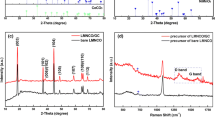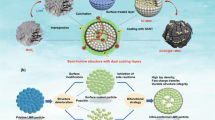Abstract
High-purity NMC111 nanoparticles are obtained by sol–gel synthesis. NMC111/MWCNTs freestanding hybrid composite cathodes are produced by a simple vacuum filtration process without detriment to both the crystalline and morphologic structures of the NMC111 nanoparticles. NMC111/MWCNTs freestanding hybrid composite cathode materials exhibit enhanced cycling stability, long cycle life, and high specific discharge capacity compared with pure NMC111 electrode, which is prepared by the classic slurry method. After 1000 cycles, within 2.5–4.6 V working potential range (at 1 C-rate), the specific discharge capacity of NMC111/MWCNTs freestanding hybrid composite cathode is 118.5 mAh g−1 with a capacity loss rate of 44.2%, considerably higher than the result of pure NMC111 cathode electrode (84.9 mAh g−1 with a capacity loss rate of 59.2%). NMC111/MWCNTs freestanding hybrid cathode has shown lower polarization and good cyclic stability when compared with the pristine NMC111 cathode electrode in the cyclic voltammetry (CV) analysis. MWCNTs in the electrode have high electron conductivity and easies the electron transfer during the electrochemical charge/discharge. Graphite@NMC111/MWCNTs full cells were fabricated to support results acquired with the half cells. To analyze the working of MWCNTs-reinforced freestanding composite cathode in full cell, graphite@NMC111/MWCNTs combination was constituted and obtained a specific discharge capacity of 150.7 mAh g−1 with a capacity loss of 30.4% after 1000 cycles. Extreme cycling and structural stability increased conductivity, and a high cycle number is reached by compressing the NMC111 nanoparticles between MWCNTs. Highly electrical conductive MWCNTs, which are homogeneously dispersed on around the NMC111 nanoparticles, are employed as both structural strengthening components and surface improvers for NMC111 cathode electrodes, not only for enhancing the electrical conductivity but also supplying powerful guarding to the side reactions with the liquid electrolyte. The results have shown that the MWCNTs-based freestanding electrode form can be widely used electrode type for high-level featured lithium-ion batteries.







Similar content being viewed by others
References
Nasir, F.M.; Abdullah, M.Z.; Ismail, M.A.: Experimental investigation of water-cooled heat pipes in the thermal management of lithium-ion EV batteries. Arab. J. Sci. Eng. 44(9), 7541–7552 (2019). https://doi.org/10.1007/s13369-019-03851-5
Gröger, O.; Gasteiger, H.A.; Suchsland, J.-P.: Review—electromobility: batteries or fuel cells? J. Electrochem. Soc. 162(14), A2605–A2622 (2015). https://doi.org/10.1149/2.0211514jes
Zhang, L.; Guo, J.: Understanding the reaction mechanism of lithium-sulfur batteries by in situ/operando X-ray absorption spectroscopy. Arab. J. Sci. Eng. 44(7), 6217–6229 (2019). https://doi.org/10.1007/s13369-019-03808-8
Gallagher, K.G.; Goebel, S.; Greszler, T.; Mathias, M.; Oelerich, W.; Eroglu, D.; Srinivasan, V.: Quantifying the promise of lithium-air batteries for electric vehicles. Energy Environ. Sci. 7(5), 1555–1563 (2014). https://doi.org/10.1039/c3ee43870h
Shaju, K.M.; Bruce, P.G.: Macroporous LiNi1/3Mn1/3Co1/3O2: a high-rate positive electrode for rechargeable lithium batteries. J. Power Sources 174(2), 1201–1205 (2007). https://doi.org/10.1016/j.jpowsour.2007.06.091
Cao, X.; Zhao, Y.; Zhu, L.; Xie, L.; Cao, X.; Xiong, S., Wang, C.: Synthesis and characterization of LiNi1/3Mn1/3Co1/3O2 as cathode materials for Li-ıon batteries via an efficacious sol–gel method. Int. J. Electrochem. Sci. 11(6), 5267–5278. https://doi.org/10.20964/2016.06.93.
Hashem, A.M.; Abdel-Ghany, A.E.; Abuzeid, H.M.; Ehrenberg, H.; Mauger, A.; Groult, H.; Julien, C.M.: LiNi1/3Mn1/3Co1/3O2 synthesized by sol–gel method: structure and electrochemical properties. ECS Trans. 50(24), 91–96 (2013). https://doi.org/10.1149/05024.0091ecst
Vallverdu, G.; Minvielle, M.; Andreu, N.; Gonbeau, D.; Baraille, I.: First principle study of the surface reactivity of layered lithium oxides LiMO2 (M = Ni, Mn, Co). Surf. Sci. 649, 46–55 (2016). https://doi.org/10.1016/j.susc.2016.01.004
Seteni, B.; Rapulenyane, N.; Ngila, J. C.; Luo, H.: Structural and electrochemical behavior of Li1.2Mn0.54Ni0.13Co0.13-xAlxO2 (x = 0.05) positive electrode material for lithium ıon battery. Mater. Today Proc. 5(4), 10479–10487 (2018). https://doi.org/10.1016/j.matpr.2017.12.379
Kim, G.-H.; Kim, J.-H.; Myung, S.-T.; Yoon, C.S.; Sun, Y.-K.: Improvement of high-voltage cycling behavior of surface-modified LiNi1/3Mn1/3Co1/3O2 cathodes by fluorine substitution for Li-ion batteries. J. Electrochem. Soc. 152(9), A1707 (2005). https://doi.org/10.1149/1.1952747
Buchberger, I.; Seidlmayer, S.; Pokharel, A.; Piana, M.; Hattendorff, J.; Kudejova, P.; Gilles, R.; Gasteiger, H.A.: Aging analysis of graphite/LiNi1/3Mn1/3Co1/3O2 Cells Using XRD, PGAA, and AC impedance. J. Electrochem. Soc. 162(14), A2737–A2746 (2015). https://doi.org/10.1149/2.0721514jes
Kim, S.J.; Lee, A.Y.; Park, H.C.; Kim, S.Y.; Kim, M.C.; Lee, J.M.; Kim, S.B.; Kim, W.S.; Jeong, Y.; Park, K.W.: carbon nanotube web-based current collectors for high-performance lithium ion batteries. Mater. Today Commun. 4, 149–155 (2015). https://doi.org/10.1016/j.mtcomm.2015.06.010
Stiaszny, B.; Ziegler, J.C.; Krauß, E.E.; Zhang, M.; Schmidt, J.P.; Ivers-Tiffée, E.: Electrochemical characterization and post-mortem analysis of aged LiMn2O4-NMC/graphite lithium ion batteries part II: calendar aging. J. Power Sources 258, 61–75 (2014). https://doi.org/10.1016/j.jpowsour.2014.02.019
Prompun, P.; Ratchahat, S.; Kaveevivitchai, W.; Kooamornpattana, W.: Carbon nanotube (CNTs) production from waste cooking oil as anode material for Li-ion batteries. J. Phys. Conf. Ser. 2175(1), 012041 (2022). https://doi.org/10.1088/1742-6596/2175/1/012041
Guoping, W.; Qingtang, Z.; Zuolong, Y.; MeiZheng, Q.: The effect of different kinds of nano-carbon conductive additives in lithium ion batteries on the resistance and electrochemical behavior of the LiCoO2 composite cathodes. Solid State Ionics 179(7–8), 263–268 (2008). https://doi.org/10.1016/j.ssi.2008.01.015
Umar, Ahmad; Ahmed, Faheem; Ibrahim, Ahmed A.; Algadi, Hassan; Albargi, Hasan B.; Alhmami, Mohsen Ali M.; Almas, Tubia; Mohammed, Ayeda Y. A.; Abuhimd, Hatem; Castañeda, L. (2021). MnO2 nanoparticles anchored multi walled carbon nanotubes as potential anode materials for lithium ıon batteries. J. Nanosci. Nanotechnol. 21(10), 5296–5301. https://doi.org/10.1166/jnn.2021.19440.
Du, Z.; Li, J.; Wood, M.; Mao, C.; Daniel, C.; Wood, D.L.: Three-dimensional conductive network formed by carbon nanotubes in aqueous processed NMC electrode. Electrochim. Acta 270, 54–61 (2018). https://doi.org/10.1016/j.electacta.2018.03.063
Pan, C. Chi; Zhu, Y. Rong; Yang, Y. Chang; Hou, H. Shuai; Jing, M. Jun; Song, W. Xin; Yang, X. Ming; Ji, X. Bo: Influences of transition metal on structural and electrochemical properties of Li[NixCoyMnz]O2 (0.6≤x≤0.8) cathode materials for lithium-ıon batteries. Trans. Nonferrous Met. Soc. China (English Ed.) 26(5), 1396–1402 (2016). https://doi.org/10.1016/S1003-6326(16)64244-9
Youn, D.Y.; Kim, C.; Cheong, J.Y.; Cho, S.H.; Yoon, K.R.; Jung, J.W.; Kim, N.H.; Kim, I.D.: Stable and high-capacity Si electrodes with free-standing architecture for lithium-ion batteries. ACS Appl. Energy Mater. 3(1), 208–217 (2020). https://doi.org/10.1021/acsaem.9b01274
Spencer, M.A.; Augustyn, V.: Free-standing transition metal oxide electrode architectures for electrochemical energy storage. J. Mater. Sci. 54(20), 13045–13069 (2019). https://doi.org/10.1007/s10853-019-03823-y
Abouimrane, A.; Ding, J.; Davidson, I.J.: Liquid electrolyte based on lithium bis-fluorosulfonyl imide salt: aluminum corrosion studies and lithium ion battery investigations. J. Power Sources 189(1), 693–696 (2009). https://doi.org/10.1016/j.jpowsour.2008.08.077
Guler, A.; Gungor, H.; Ozcan, S.; Coban, A.; Guler, M.O.; Akbulut, H.: A high-performance composite positive electrode based on graphene and Li(Ni1/3 Co1/3Mn1/3)O2. Int. J. Energy Res. 42(14), 4499–4511 (2018). https://doi.org/10.1002/er.4198
Nisa, S.S.; Rahmawati, M.; Yudha, C.S.; Nilasary, H.; Nursukatmo, H.; Oktaviano, H.S.; Purwanto, A.: A fast approach to obtain layered transition-metal cathode material for rechargeable batteries. Batteries 8(1), 4 (2022). https://doi.org/10.3390/batteries8010004
Li, X.; Zhao, X.; Wang, M.S.; Zhang, K.J.; Huang, Y.; Qu, M.Z.; Zheng, J.M.: Improved rate capability of a LiNi1/3Co1/3Mn1/3O2/CNT/graphene hybrid material for Li-ion batteries. RSC Adv. 7(39), 24359–24367 (2017). https://doi.org/10.1039/c7ra03438e
Yoon, S.; Jung, K. N.; Yeon, S. H.; Jin, C. S.; Shin, K. H. Electrochemical properties of LiNi0.8Co0.15Al0.05O2-graphene composite as cathode materials for lithium-ıon batteries. J. Electroanal. Chem. 683, 88–93 (2012). https://doi.org/10.1016/j.jelechem.2012.08.005
Serpone, N.; Lawless, D.; Khairutdinov, R.: Size effects on the photophysical properties of colloidal anatase TiO2 particles: size quantization or direct transitions in this indirect semiconductor? J. Phys. Chem. 99(45), 16646–16654 (1995). https://doi.org/10.1021/j100045a026
Hu, G.; Liu, W.; Peng, Z.; Dua, K.; Cao, Y. Synthesis and electrochemical properties of LiNi0.8Co0.15Al0.05O2 prepared from the precursor Ni0.8Co0.15Al0.05OOH. J. Power Sources 198, 258–263 (2012). https://doi.org/10.1016/j.jpowsour.2011.09.101
Julien, C. M.; Mauger, A.; Trottier, J.; Zaghib, K.; Hovington, P.; Groult, H. Olivine-based blended compounds as positive electrodes for lithium batteries. Inorganics 4(2) (2016). https://doi.org/10.3390/inorganics4020017.
Hwang, B.J.; Tsai, Y.W.; Chen, C.H.; Santhanam, R.: Influence of Mn content on the morphology and electrochemical performance of LiNi1-x-yCoxMnyO2 cathode materials. J. Mater. Chem. 13(8), 1962–1968 (2003). https://doi.org/10.1039/b301468c
Zhang, L.; Fu, J.; Zhang, C. Mechanical composite of LiNi0.8Co0.15Al0.05O2/carbon nanotubes with enhanced electrochemical performance for lithium-ıon batteries. Nanoscale Res. Lett. (2017). https://doi.org/10.1186/s11671-017-2143-4
Luo, W.; Liu, L.; Li, X.; Yu, J.; Fang, C. Templated assembly of LiNi0.8Co0.15Al0.05O2/graphene nano composite with high rate capability and long-term cyclability for lithium ıon battery. J. Alloys Compd. 810, 151786 (2019). https://doi.org/10.1016/j.jallcom.2019.151786
Mentbayeva, A.; Belgibayeva, A.; Umirov, N.; Zhang, Y.; Taniguchi, I.; Kurmanbayeva, I.; Bakenov, Z.: High performance freestanding composite cathode for lithium-sulfur batteries. Electrochim. Acta 217, 242–248 (2016). https://doi.org/10.1016/j.electacta.2016.09.082
Yudha, C.S.; Muzayanha, S.U.; Widiyandari, H.; Iskandar, F.; Sutopo, W.; Purwanto, A. Synthesis of LiNi0.85Co0.14Al0.01O2 cathode material and ıts performance in an NCA/graphite full-battery. Energies 12, 1886 (2019). https://doi.org/10.3390/en12101886
Gupta, H.; Singh, S.K.; Singh, V.K.; Tripathi, A.K.; Srivastava, N.; Tiwari, R.K.; Mishra, R.; Meghnani, D.; Singh, R.K.: Development of polymer electrolyte and cathode material for Li-batteries. J. Electrochem. Soc. 166(3), A5187–A5192 (2019). https://doi.org/10.1149/2.0331903jes
Shaju, K.M.; Subba Rao, G.V.; Chowdari, B.V.R.: Performance of layered Li(Ni1/3Co1/3Mn1/3)O2 as cathode for Li-ion batteries. Electrochim. Acta 48(2), 145–151 (2002). https://doi.org/10.1016/S0013-4686(02)00593-5
Qin, G.; Wu, Q.; Zhao, J.; Ma, Q.; Wang, C.: C/LiFePO4/multi-walled carbon nanotube cathode material with enhanced electrochemical performance for lithium-ion batteries. J. Power Sources 248, 588–595 (2014). https://doi.org/10.1016/j.jpowsour.2013.06.070
Kim, D.W.; Zettsu, N.; Teshima, K.: Three-dimensional SWCNT and MWCNT hybrid networks for extremely high-loading and high rate cathode materials. J. Mater. Chem. A 7(29), 17412–17419 (2019). https://doi.org/10.1039/c9ta03870a
Wagner, N.P.; Asheim, K.; Vullum-Bruer, F.; Svensson, A.M. Performance and failure analysis of full cell lithium ıon battery with LiNi0.80Co0.15Al0.05O2 and silicon electrodes. J. Power Sources 437, 226884 (2019). https://doi.org/10.1016/j.jpowsour.2019.226884
Song, C.; Wang, W.; Peng, H.; Wang, Y.; Zhao, C.; Zhang, H.; Tang, Q.; Lv, J.; Du, X.; Dou, Y.: Improving the electrochemical performance of LiNi0.80Co0.15Al0.05O2 in lithium ıon batteries by LiAlO2 surface modification. Appl. Sci. (2018). https://doi.org/10.3390/app8030378
Wu, F.; Yan, Y.; Wang, R.; Cai, H.; Tong, W.; Tang, H.: Synthesis of LiCo1/3Ni1/3Mn1/3O2 @graphene for lithium-ion batteries via self-assembled polyelectrolyte layers. Ceram. Int. 43(10), 7668–7673 (2017). https://doi.org/10.1016/j.ceramint.2017.03.066
Ivanishchev, A.V.; Churikov, A.V.; Ivanishcheva, I.A.; Ushakov, A.V.: Lithium diffusion in Li3V2(PO4)3-based electrodes: a joint analysis of electrochemical impedance, cyclic voltammetry, pulse chronoamperometry, and chronopotentiometry data. Ionics (Kiel). 22(4), 483–501 (2016). https://doi.org/10.1007/s11581-015-1568-y
Huang, Z.D.; Liu, X.M.; Oh, S.W.; Zhang, B.; Ma, P.C.; Kim, J.K.: Microscopically porous, interconnected single crystal LiCo1/3Ni1/3Mn1/3O2 cathode material for lithium ion batteries. J. Mater. Chem. 21(29), 10777–10784 (2011). https://doi.org/10.1039/c1jm00059d
He, J.R.; Chen, Y.F.; Li, P.J.; Wang, Z.G.; Qi, F.; Liu, J.B.: Synthesis and electrochemical properties of graphene-modified LiCo1/3Ni1/3Mn1/3O2 cathodes for lithium ion batteries. RSC Adv. 4(5), 2568–2572 (2014). https://doi.org/10.1039/c3ra45115a
Funding
This study was funded by Sakarya University of Applied Sciences.
Author information
Authors and Affiliations
Corresponding author
Rights and permissions
About this article
Cite this article
Coban, A., Gungor, H. The Carbon-Based 3D-Hierarchical Cathode Architecture for Li-Ion Batteries. Arab J Sci Eng 47, 7147–7155 (2022). https://doi.org/10.1007/s13369-022-06725-5
Received:
Accepted:
Published:
Issue Date:
DOI: https://doi.org/10.1007/s13369-022-06725-5




